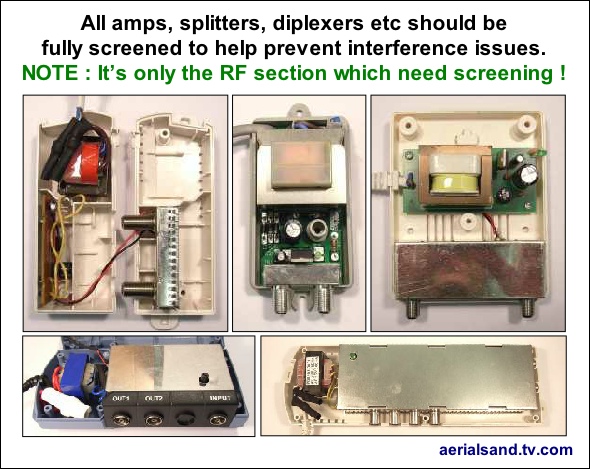Effect of screening on reduction in RF TV interference
We’ve frequently been asked whether it’s OK to run Co Ax next to mains cables and, to be frank, we didn’t really know for sure. We finally got round to trying to find out in Aug 2008 with a simple but, we feel, appropriate experiment.
NOTE : these tests, and the advice below, are equally relevant for people suffering interference from sources other than a mains cable being next to your CoAx, e.g interference from cordless phones and LED lights.
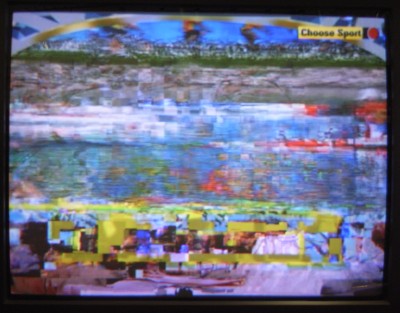
Does decent quality cable reduce interference ? The tests :
We taped a 12m length of Low Loss CoAx, and of copper/copper satellite cable, to a mains flex. Then we used a signal generator to supply the signal, and at the fairly low level (for analogue) of only 65dBμV as well, to try and encourage as much chance interference as possible.
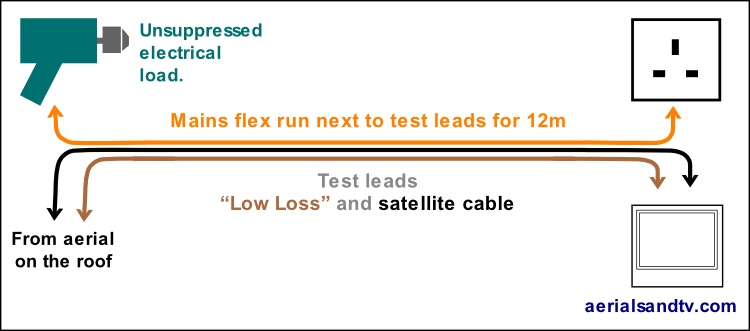
We taped a 12m length of Low Loss CoAx, and of copper/copper satellite cable, to a mains flex. Then we used a signal generator to supply the signal, and at the fairly low level (for an analogue signal) of only 65dBμV as well, to try and encourage as much chance interference as possible.
But how to detect the noise ?
We used a spectrum at first, but really that was just trying to be flash because a TV is just as likely to reveal any interference (particularly on an analogue signal) !
As an electrical load we thought a vacuum cleaner would suffice, and as ours is 1800W it should certainly draw some current, and hopefully generate a few mains spikes on start up.
We connected up the Sat cable, then rather tentatively we switched on the vac, there was no interference whatsoever. We then switched the vac on and off repeatedly to try and generate some spikes on the mains, still no interference. Next we used a 6dB attenuator to drop the signal even further, still no interference. Finally we routed the cable bundle through 20ft of alloy tubing to simulate ducting and keep any radiated interference close to the Co Ax (?).
Result ?
Still no interference.
We also repeated each experiment with ordinary Low Loss CoAx, and I have to tell you that in this test there was no detectable interference with that either. That said, I have heard of cheap Low Loss CoAx introducing RF crosstalk to adjacent cables when bundled together, although this obviously isn’t at 50Hz main frequency. But see below......
But something in the back of my mind was nagging away at me.....
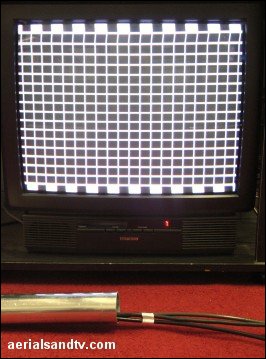
I decided to repeat the experiment with a load which may generate more electrical noise.
I dragged out my trusty 1980s Black & Decker drill and thought I’d use that as a load instead. Incidentally those were the days when B & D made decent tools because that drill has had some use, and I mean some right hammer, and it still works fine, other than a replacement chuck.
I checked that when used right next to the set it did actually introduce noise to the screen, and it did if one “played” the switch and the variable speed (under load).
The vac on the other hand didn’t produce any noise thus indicating that the above tests with it were only valid for electrical loads which are suppressed, which most are to be fair.
Using the copper/copper satellite cable (with the mains cable from the drill taped to the side of it) there was no interference on the set or blocking on the Freeview box we used as a test. But, and this is significant, as stated above there was a bit of noise if the drill was operated right next to the TV or the digital STB. The drill was producing noise, which can interfere with the tuner(s) by direct radiation, i.e. nothing to do with the signal cable.
But when the drill was operated at a distance of more than a few metres away (when using the satellite cable) there was no interference introduced to the signal via the cable.
We then repeated the test using Low Loss CoAx and I’m pleased to say that my negative opinion of it was vindicated. With the signal cable taped to the mains cable from the drill there was significant interference on the screen and blocking on the Freeview box.
Just to be sure we swapped back and forth between them and the results were consistent.
I thought “Low Loss” was crap, but I didn’t think it was that crap.....
We were in the swing of it now, so we next tried RG6 type satellite cable and it was far better than Low Loss. In fact there was hardly any difference between it and the copper foil type cable (the big difference between alloy foil and copper foil type cable, is how long they last..... ).
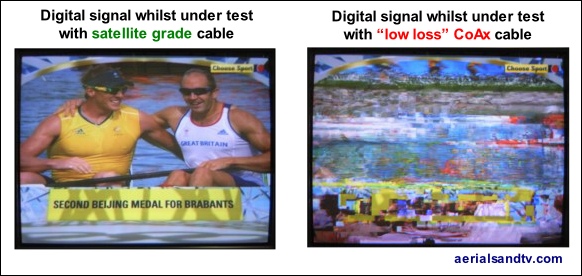
Conclusion
Whilst I’m not prepared to say anything for certain, especially with RF, I think it is reasonable to conclude that, provided it is satellite grade, mains borne interference is not usually introduced to the signal through the cable.
The same cannot be said for Low Loss type CoAx cable.
Also see this interesting customer report on cable interference problems.
However even with the best quality cable it is still possible to get interference but that is more likely to be by direct radiation onto the tuner(s). It could also be through unscreened splitters, amps or surface plates or even straight onto the aerial, though baluns and Log Periodics are supposed to limit the effects of it. It is also possible to get noise up through the mains and the use of filter type mains adapters may help with that, may being the operative word because all TVs/STBs should normally have internal mains chokes anyway.....
The best remedy for interference is to track down the cause and cure it at source, e.g. if your central heating thermostat is noisy and creating electrical interference replace it with a suppressed one. Other significant causes of interference for digital TV can be cordless phones, particularly digital ones (try moving the base station away from the TV or STB) and LED lights / lighting. We’ve had more than one customer who has cured the latter problem by swapping crappy cable for copper / copper satellite cable. Once we had a report that a blue tooth adapter was knocking out reception of CH56 ! Not sure how ! ! The moral of this story is suspect everything RF / EM spectrum related ?
The high power 4G/5G transmissions make good screening even more important, be warned !
Having said all of the above, I’d still only route CoAx cable next to mains cable if I really had to.
But if you have no choice I’d definitely make sure it was satellite grade.......
Also see mains cable next to CoAx : the regulations, and flyleads and HDMI interference.
Finally, in addition to decent cable, always use screened amps, splitters and wall plates / surface plates.
